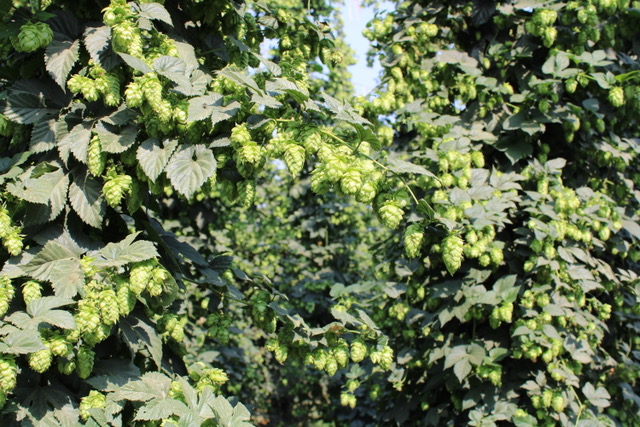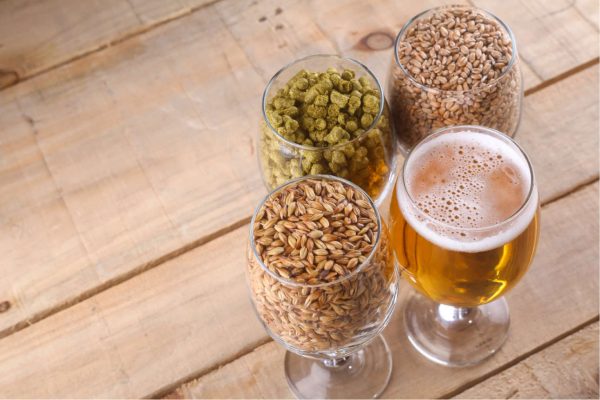
By Stan Hieronymus
The first time Jason Pellett brewed a beer with Azacca hops was the maiden batch at Orpheus Brewing. “I had never had a beer so pineappley,” he said.
Like Orpheus, which opened in 2014, Azacca was a newcomer, previously known as ADHA483. “It seemed like it had a good oil mix, and it was available,” Pellet said. Growers planted 17 acres in 2013 and about 80 in 2014. Acreage has since expanded to more than 730 in 2021, and Azacca’s reputation continues to grow globally.
Hopzoil, the Montana-based company that steam distills freshly picked hops, sells about 75 percent of its extracted essential oils internationally. Azacca and El Dorado are the two most popular varieties.
Azacca–named after the Haitian god for agriculture–came out of the breeding program owned by Roy Farms, Wyckoff Farms, and Green Acre Farms. The three farms were initially called the American Dwarf Hop Association but have been renamed the Association for the Development of Hop Agronomy (ADHA) due to their emphasis shifting away from strictly low-trellis hops.
Azacca is considered a semi-dwarf, meaning that it carries and expresses dwarfing genetics but can be farmed on a standard 18-foot trellis. Dwarfing traits include shorter internode distance, cone production from top to bottom of the bine, and a high cone to leaf ratio. It typically yields at least 2,400 pounds of hops per acre. (For the sake of comparison, in an average year in the Yakima Valley, Cascade will yield about 1,900 pounds per acre, Bravo 3,000 pounds, and Citra 1,600.)
Azacca is a descendent of Toyomidori, a hop bred by Kirin Brewery Company in Japan but of American and European heritage. The male hop used to breed Toyomidori has moderate downy mildew tolerance and high powdery mildew tolerance/resistance. Summit is the grandmother on the father’s side. In 2003, when Japanese scientist Toru Kishimoto identified 4-mercapto-4-methylpentan-2-one (4MMP) as a significant contributor to tropical aromas in beer, he measured some of the highest levels in Summit. As a result, Azacca hops have agronomic characteristics that appeal to growers and unique aroma compounds brewers seek.
The heat dome that settled over the northwest at the end of June 2021, pushing temperatures in the Yakima Valley to 115°F, was a test for many varieties.
“There were a range of reactions we saw in the dwarf/semi-dwarf hop varieties in response to heat stress,” reported Megan Twomey, agronomist and brand manager at ADHA. “The most positive observation we had was that none of them expressed any yellowing, wilt, or die back as was seen in other commercial varieties. The biggest negative that I saw was that some of our semi-dwarf (experimental) varieties that are more on the dwarfing side completely stopped growing.”
“These extreme events this summer were excellent for us to see what lines are better suited to climate extremes that will likely become more frequent in the future.”
Because of the high cone-to-leaf ratio, there is less waste to manage after harvest. On average, Azacca requires 15 percent less irrigation. “Blended with the dwarfing genetics Azacca got from its grandmother (Summit) and ADHA father, we have a high yielding, powdery mildew tolerant, unique variety that held up exceptionally well during the temperature extremes,” Twomey said.
Some of the ingredients in Transmigration of Souls, a double IPA, have changed since the first time Pellet made it on May 1, 2014, but Azacca remains at the center of aroma and flavor. He’s added the variety to other IPAs since, and Azacca and Mosaic are used in equal parts in Elusory, the brewer’s year-round hazy IPA.
“It pulls in a lot of the good stuff in American hops, very round. It’s got dankness, a bit of pine,” he said.
It has been part of a beer “I’ve had in my mind” that I’ve been meaning to brew for some time. “Basically, think about a golden IPA, more reminiscent of some (past) northwest IPAs,” he said.
“Use Golden Promise for more rounded malt character, no crystal. The water more in that direction than New England,” he said, thinking out loud about the accompanying recipe.
“Feels like,” he said, pausing for a full minute, “a more modern West Coast IPA. Softer, less-resin, very aromatic.”
“Something about Azacca makes me want this malt character,” drawing a comparison to Paulaner Pils. “Rounded, bready, not toasted. The malt is what I want in most lagers. Very rounded.”
This is the beer he was thinking about when he first read descriptions of Cold IPA, but the examples he has tasted don’t have the malt character he expected. This recipe is intended to. “Now I am really looking forward to brewing it myself,” he said.


About the Author
Stan Hieronymus is a professional journalist and amateur brewer who has made beer his beat since 1993. His travels have taken him to breweries in every state in the country. The editor at RealBeer.com, he’s penned hundreds of articles for periodicals and publications and has co-authored four books with his wife, Daria Labinsky: For the Love of Hops: The Practical Guide to Aroma, Bitterness and the Culture of Hops (2012), Brewing Local (2016), Brewing with Wheat (2010) and Brew like a Monk (2005) for Brewers Publications and contributed to several other publications, including 1001 Beers You Must Taste Before You Die.
Find Stan’s books on BrewersPublications.org.



Share Post